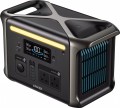Add to comparison |  |  |
|---|---|---|
| EcoFlow DELTA 3 1500 | ANKER SOLIX F1500 | |
from £59.00 | Compare prices 4 | |
| User reviews | ||
| TOP sellers | ||
4 USB A ports, 2 USB C ports. Car cigarette lighter. LiFePo4 battery. Backlight. UPS function. | ||
| In box | charging station | charging station |
| Rated power | 1800 W | 1800 W |
| Peak power | 3600 W | 2400 W |
| Output waveform | sinusoid (PSW) | sinusoid (PSW) |
| UPS function | ||
Outputs | ||
| Sockets (230 V) | 4 | 2 |
| USB A | 2 5В/2.4А 12 W | 4 5В/2.4А 12 W |
| USB A (quick charge) | 2 5В/2.4A, 9В/2A, 12В/1.5A 18 W | |
| USB C | 2 3 A, 5 A 100 W | 2 3 A, 5 A 100 W |
| Car cigarette lighter | ||
Inputs (station charging) | ||
| From solar panels | ||
| Input port XT60 | ||
| Add. ports | Extra Battery Port | C13/14 (charging) |
Battery and charging time | ||
| Connecting an additional battery | ||
| Battery type | LiFePO4 | LiFePO4 |
| Battery capacity | 1536 W*h | 1536 W*h |
| Charging cycles | 3000 | 3000 |
| Charging time (socket) ≈ | 90 min | 120 min |
| Charging time (solar panel) ≈ | 210 min | 216 min |
| Charging time (cigarette lighter) ≈ | 912 min | |
| Charging power (socket) | 1500 W | 1000 W |
| Charging power (solar panel) | 500 W | 600 W |
| Charging power (cigarette lighter) | 120 W | |
General | ||
| Smartphone synchronization | Bluetooth and WiFi | |
| PSU | built into the body | built into the body |
| Display | ||
| Backlight | ||
| Carrying handle | ||
| Operating temperature | 0 °C ~ +45 °C | 0 °C ~ +40 °C |
| Dimensions | 398x213x282 mm | 288x463x237 mm |
| Weight | 16 kg | 19.8 kg |
| Warranty | 5 years | |
| Added to E-Catalog | november 2024 | july 2024 |
Comparing the charging stations EcoFlow DELTA 3 1500 and ANKER SOLIX F1500, several key points can be highlighted. Both models have a nominal power of 1800 W and use LiFePO4 batteries with a charge cycle of up to 3000 times. However, EcoFlow offers a higher peak power of 3600 W, while ANKER is limited to 2400 W. EcoFlow also has more outputs: 4 sockets at 230 V compared to 2 for ANKER, which makes it more versatile for connecting devices. The charging time from a socket for EcoFlow is about 90 minutes, which is faster than the 120 minutes for ANKER. Nevertheless, ANKER has additional functions such as lighting and a greater number of USB ports, which can be useful for users. Overall, the EcoFlow DELTA 3 1500 appears more powerful and faster, whereas the ANKER SOLIX F1500 offers additional conveniences.